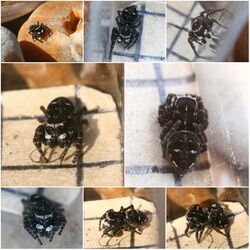Biology:Calositticus inexpectus
| Calositticus inexpectus | |
|---|---|

| |
| Scientific classification | |
| Domain: | Eukaryota |
| Kingdom: | Animalia |
| Phylum: | Arthropoda |
| Subphylum: | Chelicerata |
| Class: | Arachnida |
| Order: | Araneae |
| Infraorder: | Araneomorphae |
| Family: | Salticidae |
| Genus: | Calositticus |
| Species: | C. inexpectus
|
| Binomial name | |
| Calositticus inexpectus Logunov & Kronestedt, 1997[1]
| |
| Synonyms[1] | |
| |
Calositticus inexpectus is a species of spider from Salticidae family, that can be found in from Europe (including southern England[2]) to Central Asia.[1] It was previously misidentified as Calositticus rupicola (syn. Sitticus rupicola).[3]
Until 2017 it was placed in the genus Sitticus.[1]
Description
Calositticus inexpectus females have a body length of about 6–7 mm (0.24–0.28 in), males being slightly smaller at about 4–5 mm (0.16–0.20 in).[4] The fourth leg is the longest, about 5.5 mm (0.22 in) in females and about 4 mm (0.16 in) in males. Both sexes are generally brown to dark brown in overall coloration, males being darker than females. Both the carapace and abdomen have stripes and patterns formed by whitish or otherwise paler hairs, the carapace pattern being more distinct in males, with three longitudinal whitish stripes and a similarly coloured lateral border with the posterior part having a short line extending inwards.[3]
Taxonomy
Calositticus inexpectus was first described in 1997 by Dimitri Logunov and Torbjörn Kronestedt (as Sitticus inexpectus).[1] The specific name inexpectus means "unexpected"; the species was separated from Calositticus rupicola (then Sitticus rupicola), the authors stating, for example, that all spiders previously identified as S. rupicola in England were in fact the new species C. inexpectus (then Sitticus inexpectus). The two species can be distinguished by the pattern of white hairs on the carapace of the male – in C. inexpectus there is usually a short white stripe extending inwards from the posterior part of the carapace, and by the detailed shapes of the male palpal bulb and the internal female genitalia. C. inexpectus is a lowland species, whereas C. rupicola is found at higher altitudes.[3]
The species was transferred from Sitticus to the new genus Sittiflor in 2017, but this was later discovered to be pre-empted by Calositticus.[1]
Distribution and habitat
Calositticus inexpectus is found from southern England through central and northern Europe (Germany, Austria, Sweden, Poland, Estonia and Russia) to central Asia (Kazakhstan and Kyrgyzstan). It is a lowland species (thus contrasting with C. rupicola), typically found near to water, either coastal or inland.[3] In southern England, where the species can be found from April to October, it lives in coastal shingle and tidal litter, often adjacent to saltmarshes.[2]
References
- ↑ 1.0 1.1 1.2 1.3 1.4 1.5 "Taxon details Calositticus inexpectus (Logunov & Kronestedt, 1997)". World Spider Catalog. Natural History Museum Bern. http://www.wsc.nmbe.ch/species/32740. Retrieved 29 September 2018.
- ↑ 2.0 2.1 "Summary for Sitticus inexpectus (Araneae)". British Arachnological Society. http://srs.britishspiders.org.uk/portal.php/p/Summary/s/Sitticus+inexpectus. Retrieved 2 September 2017.
- ↑ 3.0 3.1 3.2 3.3 Logunov, D.V. &; Kronestedt, T. (1997). "A new Palearctic species of the genus Sitticus Simon, with notes on related species in the floricola group (Araneae, Salticidae)". Bulletin of the British Arachnological Society 10: 225–233.
- ↑ Roberts, M.J. (1995). Collins Field Guide: Spiders of Britain & Northern Europe. London: HarperCollins. ISBN 978-0-00-219981-0. (As Sitticus rupicola.)
Wikidata ☰ {{{from}}} entry

